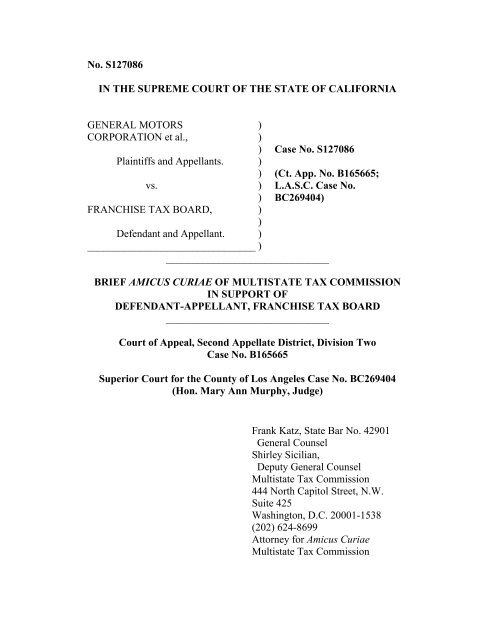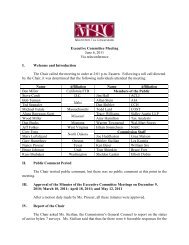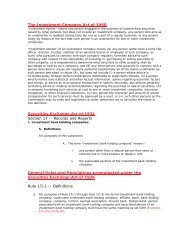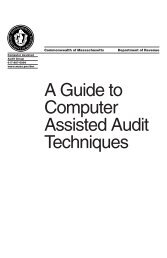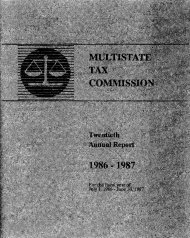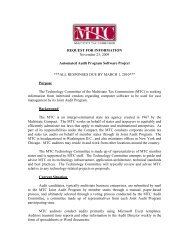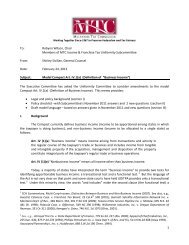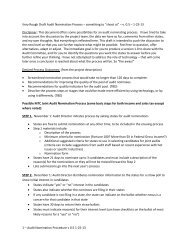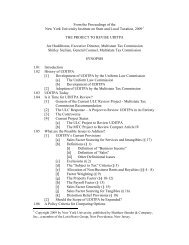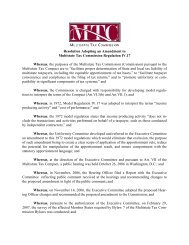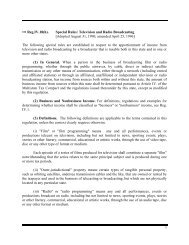General Motors v. California Franchise Tax Board - Multistate Tax ...
General Motors v. California Franchise Tax Board - Multistate Tax ...
General Motors v. California Franchise Tax Board - Multistate Tax ...
Create successful ePaper yourself
Turn your PDF publications into a flip-book with our unique Google optimized e-Paper software.
TABLE OF CONTENTSPageINTEREST OF AMICUS CURIAE MULTISTATE TAXCOMMISSION ........................................................................................ 1ARGUMENT ............................................................................................... 6I. The Commission Interprets UDITPA to ExcludeReturns of Principal from the Sales Factor ........................................ 6A. Returns of Principal Are Not Part of Gross Receipts .................. 7B. Treating Returns of Principal as Gross ReceiptsWould Create Distortion .............................................................. 91. Including Principal in the Sales Factor WouldDistort the Apportionment Result for Each <strong>Tax</strong>payerwith a Treasury Function in Another State byIncorrectly Reflecting the Location of the <strong>Tax</strong>payer’sIncome Producing Activities................................................ 102. Including Principal in the Sales Factor WouldProduce Distortion by Allowing SubstantiallyDifferent Apportionment Results Across SimilarlySituated <strong>Tax</strong>payers ................................................................ 13II. Neither Unitary Theory Nor UDITPA Requires a<strong>Tax</strong> Credit Earned by One Member of a UnitaryGroup to be Usable by All Members ............................................... 14CONCLUSION .......................................................................................... 17-ii-
TABLE OF AUTHORITIESPageCASES:Allied-Signal Inc. v. Director, Div. of <strong>Tax</strong>ation (1992)504 U.S. 768 ........................................................................................ 4American Telephone & Telegraph Co. v. Director,Division of <strong>Tax</strong>ation (<strong>Tax</strong> Ct. 1982) 4 N.J. <strong>Tax</strong> 638,aff’d and modified (N.J. Super. App. Div. 1984)476 A.2d 800, cert. denied (1984) 97 N.J. 627 ................................. 10American Telephone & Telegraph Co. v. State <strong>Tax</strong>Appeal <strong>Board</strong> (Mont.1990) 787 P.2d 754 ......................................... 10Appeals of Pacific Telephone & Telegraph Co.,Cal.St.Bd. of Equal. (May 4, 1978) 78 SBE 028.........................10, 11Nebraska Dept. of Revenue v. Loewenstein (1994)513 U.S. 123 ........................................................................................ 8Sherwin-Williams v. Indiana Dept. of StateRevenue (Ind. <strong>Tax</strong> 1996) 673 N.E.2d 849 ......................................... 10United States Steel Corp. v. <strong>Multistate</strong> <strong>Tax</strong>Comm’n (1978) 434 U.S. 452............................................................. 2AGENCY RULINGS:N.Y. Corp. <strong>Tax</strong> Advisory Op. TSB-A-88(21)(C)(1988 Pet. No. C880718A The Lomas & Nettleton Co.)..................... 5CALIFORNIA STATUTORY MATERIAL:Cal. Stats. 1966, c. 2 ................................................................................ 2Cal. Stats. 1974, c. 93 .............................................................................. 2Revenue and <strong>Tax</strong>ation Code§ 25120 et seq. ..................................................................................... 2§ 25120(e) ........................................................................................... 6§ 25121 .............................................................................................. 14§ 25138 ............................................................................................... 3§ 38006 et seq. ..................................................................................... 2-iii-
Page§ 38006, Art. I...................................................................................... 3§ 38006, Art. XII ................................................................................. 3OTHER STATUTORY MATERIALS:MULTISTATE TAX COMPACT, RIA STATE & LOCALTAXES: ALL STATES TAX GUIDE (2005) ................................................... 2Art. I..................................................................................................... 3Art. IV.................................................................................................. 2Art. IV.18 .......................................................................................... 10Art. VII................................................................................................. 2Art. VII.1.............................................................................................. 2Art. VII.2.............................................................................................. 7Art. XII................................................................................................. 3PUB. LAW 86-272, TITLE II, 73 STAT. 555 (1959).................................... 3MULTISTATE TAX COMMISSION REGULATORY MATERIALS:<strong>Multistate</strong> <strong>Tax</strong> Commission Allocation andApportionment Regulations, IV.2(a)(5),http://www.mtc.gov/UNIFORM/alloc_and_apport%20regs.pdf.......................................................7, 8, 9, 12<strong>Multistate</strong> <strong>Tax</strong> Commission Allocation andApportionment Regulations, IV.18(c)(4),http://www.mtc.gov/UNIFORM/alloc_and_apport%20regs.pdf; RIA STATE & LOCAL TAXES:ALL ST. TAX GUIDE 667.25 et seq., (2005) ...........................7, 10, 12FEDERAL MATERIALS:H.R. REP. NO. 952, 89 th Cong., 1 st Sess.,Pt. VI (1965) ....................................................................................... 3H.R. REP. NO. 1480, 88 th Cong., 2 nd Sess.(1964) .................................................................................................. 4OTHER AUTHORITIES:Hellerstein & Hellerstein, State <strong>Tax</strong>ation (3 rd ed.,updated through Nov. 2004).............................................................. 11-iv-
Page<strong>Multistate</strong> <strong>Tax</strong> Commission Proposed ModelUniform Statute for Combined Reporting,http://www.mtc.gov/UNIFORM/CRDraftStatute11-11-04.pdf ........................................................................... 16William J. Pierce, The Uniform Division of Incomefor State <strong>Tax</strong> Purposes, 35 TAXES 747 (1957) .........................4, 14-15William J. Pierce, Uniform Act Urged as PracticalMethod to Lighten State <strong>Tax</strong> Compliance Burden,12 J.<strong>Tax</strong>’n 83 (1960).......................................................................... 11-v-
IN THE SUPREME COURT OF THE STATE OF CALIFORNIAGENERAL MOTORSCORPORATION et al.,))) Case No. S127086Plaintiffs and Appellants. )vs.)))(Ct. App. No. B165665;L.A.S.C. Case No.BC269404)FRANCHISE TAX BOARD,Defendant and Appellant.)))________________________________ )_______________________________INTEREST OF AMICUS CURIAEMULTISTATE TAX COMMISSIONAmicus Curiae <strong>Multistate</strong> <strong>Tax</strong> Commission (Commission) files thisbrief in support of Defendant-Appellant <strong>Franchise</strong> <strong>Tax</strong> <strong>Board</strong> (FTB). TheCommission agrees with the FTB and the <strong>California</strong> Court of Appeal thatreturns of principal should not be included in the sales factor used forapportioning a taxpayer’s business income under the Uniform Division ofIncome for <strong>Tax</strong> Purposes Act (UDITPA). The importance the Commissionattaches to a correct and uniform construction of UDITPA on this pointinduced the Commission to promulgate two uniformity recommendations,both of which are consistent with the FTB’s position and the current rule oflaw in the overwhelming majority of other states (FTB’s Answer Brief[FTB’s Br.] at pp. 19-22), and is our primary motivation for filing this brieftoday.In addition, the Commission files to express its agreement with theFTB that nothing in UDITPA, or in unitary theory in general, requires oreven implies that tax credits earned by one taxpayer member of a combinedgroup must be usable by other members of the combined group. Indeed,
the Commission’s own draft model statute on combined reporting limits theuse of credits to the individual taxpayer that earns them, unless the statutorylanguage of a particular credit specifically provides otherwise.The Commission is the administrative agency for the <strong>Multistate</strong> <strong>Tax</strong>Compact, which became effective in 1967 when the required minimumnumber of states adopted it. 1 (See RIA State & Local <strong>Tax</strong>es: All States <strong>Tax</strong>Guide 701 et seq. (2005).) Article IV of the Compact incorporatesUDITPA almost word for word. And, Article VII charges the Commissionwith interpretation of UDITPA through promulgation of model regulations.(Compact, Art.VII.1.) Forty-seven states are now members of theCommission, including <strong>California</strong> which enacted the Compact in 1974. 2(See Cal. Stats. 1974, c. 93.) The substantive provisions of the Compact arefound in <strong>California</strong> Revenue & <strong>Tax</strong>ation Code 3 section 38006. <strong>California</strong>also enacted UDITPA separately in 1966, prior to its adoption of theCompact. (See Cal. Stats. 1966, c. 2; Rev. & <strong>Tax</strong>. Code, § 25120 et seq.)The Commission’s statutory responsibility to recommend uniforminterpretations of UDITPA addresses what is perhaps the most fundamentalpurpose of the Compact – to “promote uniformity or compatibility in1 The U.S. Supreme Court upheld the validity of the Compact in UnitedStates Steel Corp. v. <strong>Multistate</strong> <strong>Tax</strong> Comm’n (1978) 434 U.S. 452.2 In addition to <strong>California</strong>, the current full members are the states ofAlabama, Alaska, Arkansas, Colorado, District of Columbia, Hawaii,Idaho, Kansas, Maine, Michigan, Minnesota, Missouri, Montana, NewMexico, North Dakota, Oregon, South Dakota, Texas, Utah, andWashington. The five sovereignty members are the states of Florida,Kentucky, Louisiana, New Jersey and Wyoming. The associate membersare the states of Arizona, Connecticut, Georgia, Illinois, Maryland,Massachusetts, Mississippi, New Hampshire, New York, North Carolina,Ohio, Oklahoma, Pennsylvania, South Carolina, Tennessee, Vermont, WestVirginia, and Wisconsin. The project members are the states of Iowa,Nebraska and Rhode Island.3 Hereinafter referred to as Rev. & <strong>Tax</strong>. Code.-2-
significant components of tax systems” (Compact, Art. I; Rev. & <strong>Tax</strong>.Code, § 38006, Art. I) and it promotes a key directive of UDITPA – that it“shall be interpreted to effectuate its general purpose to make uniform thelaw of those states that enact it.” (Rev. & <strong>Tax</strong>. Code, § 25138; see alsoCompact, Art. I; Rev. & <strong>Tax</strong> Code, § 38006, Art. I and Art. XII.) Thispurpose is central to the very existence of the Compact, which was thestates’ answer to an urgent need for reform in state taxation of interstatecommerce, especially through the development of uniformity. (See, e.g.,H.R. Rep. No. 952, 89 th Cong. 1 st Sess., Pt. VI, at 1143 (1965) [“While eachof the state laws contains its own inner logic, the aggregate of these laws –comprising the system confronting the interstate taxpayer – defies reason.Indeed, so varied are the provisions concerning jurisdiction, division ofincome, and tax base, that it is rare to find a statement which is true of allincome tax states.”].) Substantial lack of uniformity had resulted inburdensome complexity, uncertainty, compliance problems, seriousadministrative challenges, duplicate taxation and less than fullapportionment of income. If the states failed to act, Congress stood readyto enact reform itself through federal legislation that would preempt andregulate state taxation. 4The promise of uniformity established by the states’ adoption of theCompact and UDITPA was critical to preserving the recognized taxsovereignty the states enjoyed, and continue to enjoy, with respect tointerstate and now foreign commerce. Today, the need for uniformity instate taxation has only intensified as our modern economy becomes lesscentered on local business and increasingly organized around interstate and4 The Willis Committee, a congressional study of state taxation ofinterstate commerce sanctioned by Title II of Pub. L. 86-272, 73 Stat. 555,556 (1959), made extensive recommendations as to how Congress couldregulate state taxation of interstate and foreign commerce.-3-
international markets. Responding to the criticisms of Congress and theU.S. Supreme Court, 5 the states must be ever more vigilant to avoidsignificant deviations in taxing approaches.Against this backdrop of desired uniformity, <strong>General</strong> <strong>Motors</strong>(<strong>Tax</strong>payer) advocates a distinctly minority view of the term “gross receipts”that fails to interpret UDITPA’s definition of “sales” properly. Thedefinition of “sales” is a core provision of UDITPA’s division of incomerules, as “sales” are the basis for one of the three factors used to apportionmultistate business income. The definition of “sales” will therefore have avery large impact on the apportionment formula and, in turn, importantimplications for uniformity. Where the sales factor is double or multipleweighted,as it is now in <strong>California</strong> and the majority of other states, thisimpact is even larger. Deviation from a uniform understanding of thiscentral term would significantly upset the goal of both UDITPA and theCompact to avoid duplicative taxation and ensure full apportionment. (SeeWilliam J. Pierce, The Uniform Division of Income for State <strong>Tax</strong> Purposes,35 <strong>Tax</strong>es 747, 748 (1957).) Duplicative taxation was also an objectionablecharacteristic of non-uniform state income taxation identified by Congress.(H.R. REP. NO. 1480, 88 th Cong., 2nd Sess. (1964) at p. 389.)This case provides a good illustration of the potential for less thanfull apportionment should <strong>California</strong> adopt <strong>Tax</strong>payer’s proposed nonuniformdefinition of “gross receipts.” If returns of principal areimproperly included in the sales factor as <strong>Tax</strong>payer proposes, those returnswould be sourced to the location of its treasury function in New York,which would cause a larger share of <strong>Tax</strong>payer’s total multistate businessincome to be apportioned to New York. Such a formula, although5 Allied-Signal Inc. v. Director, Div. of <strong>Tax</strong>ation (1992) 504 U.S. 768,777-778 (severe multiple taxation has drastic consequences for nationaleconomy).-4-
incorrect, would not result in duplicate or less than full taxation if both<strong>California</strong> and New York were to adopt it. Rather, it would simply be thecase that more income would be sourced to New York and an equal, lesseramount would be sourced to <strong>California</strong>. But if <strong>California</strong> were to adopt aformula shifting income to New York, while New York did not adopt theformula, then there would be less than full apportionment of the <strong>Tax</strong>payer’sincome. Indeed, that is precisely what would happen should <strong>California</strong>adopt the <strong>Tax</strong>payer’s position because New York, like most other states,does not utilize <strong>Tax</strong>payer’s proposed formula. 6 By the same token, should<strong>California</strong> adopt this position while other states have not, any multistatetaxpayer whose treasury function is located in <strong>California</strong> would be subjectto duplicate taxation. And the amount of double taxation or less than fullapportionment could be significant.The significance of this issue for balanced and uniformapportionment led the Commission to promulgate two model uniformregulations. Both regulations interpret UDITPA to exclude returns ofprincipal from the sales factor, consistent with the FTB’s position, thedecision of the courts below in this case and the current rule of law in theoverwhelming majority of other states (FTB’s Br. at pp. 19-22.) YourAmicus respectfully urges this Court, an important and respected interpreterof UDITPA, to reach the same conclusion. As support, we set out therationale which the Commission followed in reaching this conclusion in our6 New York Business Corporation <strong>Franchise</strong> <strong>Tax</strong> Regulation Art. 9-A §4-4.1; see also N.Y. Corp. <strong>Tax</strong> Advisory Op. TSB-A-88(21)(C) p. 2 (1988Pet. No. C880718A The Lomas & Nettleton Co.) (“The gross proceeds fromthe sales of certificates greatly exceeds the profit, if any, realized on suchsales. … Accordingly, if such gross proceeds were included in thecomputation of Petitioner's ‘business receipts,’ as that term is used insections 4-4.1 and 4-4.6 of the Business Corporation <strong>Franchise</strong> <strong>Tax</strong>Regulations …, Petitioner’s New York business receipts factor could bedistorted and disproportionate in size to its payroll and property factors.”)-5-
Argument, below. Our interest in providing this support, and in anaffirmation of the reasonable lower court decision, is to maintain theextensive uniformity that currently exists regarding interpretation of theCompact and UDITPA on this fundamental point.Your Amicus makes this request well knowing that the currentcondition of state income tax uniformity is not perfect. Yet the concept of“sales” is a fundamental one for the uniform division of income, and iscurrently as near to a uniform concept as we could hope to come. 7 Werespectfully submit that a decision in this case which conflicts with thatprevailing view, particularly from a jurisdiction such as <strong>California</strong> thatimpacts an exceptionally large segment of total interstate commerce, wouldpose a significant obstacle to the achievement of the purposes of theCompact and UDITPA.ARGUMENTI. The Commission Interprets UDITPA to Exclude Returns ofPrincipal from the Sales Factor.The issue presented is whether the UDITPA sales factor shouldinclude the returns of principal from various types of investments. Thiscase specifically places construction of UDITPA’s definition of “sales,” aterm fundamental to the calculation of the apportionment formula, on thetable.Under UDITPA, “sales” are defined as “all gross receipts of thetaxpayer….” (Rev. & <strong>Tax</strong>. Code, § 25120(e).) But the term “grossreceipts” is not further defined. Over the span of six years, from 1995through 2001, the Commission analyzed the scope of the term “grossreceipts” in the context of returns of principal. The Commission’s analysis7 The FTB has identified 36 jurisdictions that have adopted the conceptsupported here. (FTB’s Br. at pp. 19-22.)-6-
was performed through the formal rulemaking procedures required for thedevelopment of uniform interpretations of UDITPA. These proceduresinvolved three separate public hearings, extensive written and oral publiccomment and formal polling of the Commission’s member states, all inaccordance with Article VII.2. of the Compact. The Commission’sprocedures ultimately resulted in the promulgation of two modelregulations, MTC Reg. IV.2(a)(5) (interpreting the definition of “grossreceipts” to exclude returns of principal on investments), and MTC Reg.IV.18(c)(4) (disallowing returns of principal on investment from inclusionin the sales factor as distortive of the apportionment formula). Both clearlyinterpret UDITPA to exclude returns of investment principal from the salesfactor. 8 Most states have now adopted one or both of these interpretations,whether through judicial, legislative or regulatory means, if not specificallythrough adoption of the Commission’s model regulations. Your Amicussets out the rationale for its interpretations below, and respectfully requeststhis Court consider the appropriateness of reaching a similar conclusion forlike reasons.A. Returns of Principal are Not Part of Gross Receipts.The Commission’s model Regulation IV.2(a)(5) defines “grossreceipts” and states explicitly that returns of principal from investments ofthe type at issue in this case are not included within the meaning of thatterm for purposes of UDITPA:“Gross Receipts” are the gross amounts realized (the sum of money andthe fair market value of other property or services received) on the saleor exchange of property…or the use of the property or capital (includingrents, royalties, interest and dividends) in a transaction which produces8 The Commission’s regulation MTC Regulation IV.18(c)(4) excludesall principal from the sales factor, including that associated with salestransactions occurring prior to the maturity date of an investment security(referred to as “direct sales” in the proceedings below in this case), as wellas that associated with redemptions and repurchase agreements.-7-
usiness income.... Gross Receipts, even if business income, do notinclude such items as, for example:1) repayment, maturity, or redemption of the principal of a loan, bond,or mutual fund or certificate of deposit or similar marketableinstrument;2) the principal amount received under a repurchase agreement orother transaction properly characterized as a loan….(Emphasis added.)The Commission’s rationale for this policy is that a return ofprincipal from such investment is not a “receipt” at all. It is simply thereturn, by the borrower to the lender, of the lender’s own principal. Whenthese marketable debt instruments and repurchase agreements mature, theborrower returns the taxpayer’s principal, along with an interest payment.The taxpayer is not “selling” its excess cash when it makes theseinvestments. It is lending its excess cash and earning interest income asconsideration for the loan. The transactions at issue in this case areessentially “leases” of excess cash. 9Because the return of principal from these investment transactions is,in conceptual economic and legal terms, simply the return of “leased”intangible property; for tax purposes it should be treated in a mannerperfectly comparable to the return of leased tangible property. The value ofleased tangible equipment is not considered “income” includable in grossreceipts upon its return, nor should the value of leased intangible cash beincluded as gross receipts upon its return. In both cases the transaction atissue is a lease and not a sale. Thus, in both cases, only the “amountsrealized … on … the use of the property or capital” should be included ingross receipts. (MTC Regulation IV.2(a)(5) [emphasis added].) The mere9 Nebraska Dept. of Revenue v. Loewenstein (1994) 513 U.S. 123, 134.-8-
fact that the returned intangible property may be in the form of cash shouldnot cause it to be confused with a gross receipt.Your Amicus respectfully submits, for the reasons stated above, thatonly the interest income, and not the return of principal, should beconsidered gross receipts and includable in the sales factor used toapportion business income under UDITPA.B. Treating Returns of Principal as Gross Receipts WouldCreate Distortion.Not only are returns of principal properly excluded from the salesfactor because they are not “gross receipts,” a rule which improperly allowsfor their inclusion would create unacceptable distortion of apportionmentresults. The distortion that would be created presents a distinct, but equallystrong, rationale for their exclusion. Whatever surface plausibility theremight be to stretch the term “gross receipts” to include returns of capital,the distortion it would create in the context of the apportionment salesfactor renders such an interpretation unreasonable and unacceptable.Through a treasury function, large sums of excess cash generatedfrom the sales of a core product are invested and reinvested in short-term,often overnight, securities that return, often each day, the original capitalinvestment plus a small amount of interest income. If these large sums ofcapital were continually re-counted as gross receipts attributable to thetreasury function and added to the sales factor each time they werereturned, then over the course of a year the total “gross receipts” improperlyattributed to the treasury function from this multiple counting of the samefunds could be enormous.Several early decisions noted this potential for stunning distortion-9-
and looked to Section 18 of UDITPA. 10Likewise, the Commissionpromulgated an additional model regulation under Art. IV. Section 18 ofthe Compact to separately address the issue of distortion. MTC RegulationIV.18(c)(4)(a) provides:… If a taxpayer holds liquid assets in connection with one ormore treasury functions of the taxpayer, and the liquid assetsproduce business income when sold, exchanged or otherwisedisposed, the overall net gain or loss from those transactionsfor each treasury function for the tax period is included in thesales factor.Adoption of this model regulation was predicated on theCommission’s finding that inclusion of principal in the sales factorinherently produces incongruous results. The incongruity would not belimited to isolated cases, but would distort the apportionment results forevery taxpayer that engages in a treasury function for the investment of itsexcess cash generated by sales of core product. And, because such a rulewould allow for highly variable apportionment results with little or nochange in income producing activity, distortion would also be evident insignificant arbitrary variance in the apportionment results for similarlysituated taxpayers.1. Including Principal in the Sales Factor Would Distortthe Apportionment Result for Each <strong>Tax</strong>payer with aTreasury Function in Another State by IncorrectlyReflecting the Location of the <strong>Tax</strong>payer’s IncomeProducing Activities.The philosophy of UDITPA is that multistate business income10 See Appeals of Pacific Telephone & Telegraph Company, Cal. St. Bd.of Equal. (May 4, 1978) 78 SBE 028; American Telephone & TelegraphCo. v. State <strong>Tax</strong> Appeal <strong>Board</strong> (Mont. 1990) 787 P.2d 754; AmericanTelephone & Telegraph Co. v. Director, Division of <strong>Tax</strong>ation (<strong>Tax</strong> Ct.1982) 4 N.J. <strong>Tax</strong> 638, aff’d and modified (N.J. Super. App. Div. 1984) 476A.2d 800, cert. denied (1984) 97 N.J. 627; Sherwin-Williams v. IndianaDept. of State Revenue (Ind. <strong>Tax</strong> 1996) 673 N.E.2d 849.-10-
should be apportioned based upon the location of the actual incomeproducing activities that are responsible for its realization. The purpose ofthe sales factor in the UDITPA apportionment formula is to properlyrecognize the income producing activity of selling, i.e., the contribution ofthe market states, to the creation of multistate business income. (William J.Pierce, Uniform Act Urged as Practical Method to Lighten State <strong>Tax</strong>Compliance Burden, 12 J.<strong>Tax</strong>’n 83, 84 (1960); see also Appeals of PacificTelephone & Telegraph Co., supra.)By inflating gross receipts attributable to the income producingactivity of the treasury function, the influence of the treasury function in thesales factor apportionment ratio could become entirely disproportionate tothe portion of multistate business income that is actually earned through the“lease” of those funds, i.e., the interest income. Professor Hellersteinexplains that distortion of taxpayers’ overall apportionment results wouldoccur because “there is no necessary correlation between the amount ofreceipts and the corresponding amount of income from certain types ofintangible investments:”For example, the purchase at a discount of a thirty-day $1 millioncertificate of deposit at the beginning of each month and its sale orredemption at the end of the month would yield $12 million ofreceipts during the course of a year, whereas the purchase at adiscount and subsequent sale or redemption of a one-year $1 millioncertificate of deposit would yield only $1 million of receipts. Yetthe intangible interest income earned from these investments islikely to be quite similar and clearly will not vary by a factor oftwelve.Hellerstein & Hellerstein, State <strong>Tax</strong>ation (3d ed. 2001) Part IV 9.18[4][c].This example plainly illustrates the problem. If returns of principalare included in gross receipts, then “gross receipts” attributable to thetreasury function could be inflated multiple times over with little or noincrease in either the income producing activity taking place in the treasury-11-
function state (the activity which the UDITPA sales factor is intended toreflect) or the income generated by that activity.If the only function to be represented by the sales factor were atreasury function, this inflation would not be a problem. The sales factorapportionment numerators and denominators for the states in which thetaxpayer does business would all simply vary proportionately and theapportionment result would not change. 11However, a huge incongruity arises if a treasury function is unitarywith a core function, 12 so that total business income from both functionsmust be apportioned across the states in which each is performed, based inpart on the relative amount of gross receipts contributed by each. Includingprincipal attributable to the treasury function in gross receipts would allowfor a significant shift in the percentage of total sales attributable to thetreasury functions versus the core function. Gross receipts from thetaxpayer’s core function could become increasingly overwhelmed in thesales factor, depending on the average maturity period taxpayer chooses forits treasury function investments. As the length of the taxpayer’s averagematurity period drops, the gross receipts attributable to its treasury functionwould climb, and the unvarying receipts of the core function would become11 Indeed, the Commission’s regulation allows an exception fortaxpayers who are principally engaged in the business of purchasing andselling liquid assets. (MTC Reg. IV.18(c)(4)(C).) Of course, the exceptiononly applies to the extent that the taxpayer’s transactions actually generatesales “gross receipts” within the meaning of MTC Reg. IV.2(a)(5). In thismanner, the “anti-distortion” regulation of MTC Reg. IV.18(c)(4) providesa back-stop to the gross receipts definition contained in MTC Reg.IV.2(a)(5), and prevents the sales factor from being distorted by sales oftreasury investments before they mature (referred to as “direct sales” in theproceedings below in this case).12 In this case, <strong>Tax</strong>payer’s treasury function was unitary with its corefunction - - the manufacture, assembly and sale of motor vehicles and parts.(Ct. of App. Decision filed June 30, 2004, at pp. 3-5.)-12-
increasingly underrepresented in the sales factor ratio. The result is that theamount of total business income apportioned to the states contributing tosales of the taxpayer’s core product would become increasinglyunderstated.Even fairly small variations in average maturity periods for shortterminvestments could create large variations in the “gross receipts”attributable to the treasury function state. For example, a taxpayer couldincrease its “gross receipts” attributable to its treasury function, with littleor no change in its income or income producing activity, by nearly 500percent simply by changing the average maturity period for its investmentsfrom five days to one day.A rule which allows gross receipts to be inflated in this mannerwould defeat the purpose of the UDITPA sales factor to reflect theproportionate location of all of the taxpayer’s sales-related businessactivity. Income properly attributed to the core function states wouldessentially be misattributed to the treasury function state, as the sales factoris overwhelmed by inflated treasury function receipts. 132. Including Principal in the Sales Factor WouldProduce Distortion by Allowing SubstantiallyDifferent Apportionment Results Across SimilarlySituated <strong>Tax</strong>payers.In addition, including principal in gross receipts would allow forsubstantially different apportionment results between similarly situatedtaxpayers. If one taxpayer invested in securities with an average six monthmaturity to match its capital needs cycle and another invested overnight, thegross receipts attributable to the treasury function state of one would behundreds of times that of the other. Thus, even if the two taxpayers had13 Because no states currently include such treasury function activity intheir sales apportionment factor (FTB’s Br. at pp. 19-22.), the misattributedincome would essentially escape state taxation altogether.-13-
identical income and location of business activity as measured by property,payroll and sales, the two could apportion a significantly different share oftheir income to each state in which they did business.There is simply no rationale in tax policy that would support such adivergence in these taxpayers’ apportionment factors, nor the consequentialdivergence in their state income apportionment results. Certainly, thisamount of variation for essentially similarly situated taxpayers cannot havebeen the intended, and is not an acceptable, result of the UDITPAapportionment formula.Your Amicus respectfully submits that only the interest income, andnot the return of principal, should be considered gross receipts andincludable in the sales factor used to apportion business income underUDITPA; and that, for the reasons stated above, adhering to this principle isnecessary in order to avoid serious distortion, and potential manipulation,of the UDITPA sales factor and apportionment results.II.Neither Unitary Theory Nor UDITPA Requires a <strong>Tax</strong> CreditEarned by One Member of a Unitary Group to be Usable by AllMembers.The second issue presented is whether a tax credit earned by onemember of a unitary group must be apportioned among, and usable by, allmembers of the unitary group. The Commission is in full agreement withthe FTB that nothing in UDITPA, or in unitary theory in general, requiresor even implies that tax credits earned by one taxpayer member of a unitarygroup must apportioned and usable by other members of the group. (FTB’sBr. at pp. 48-73.)The function of unitary theory and UDITPA together is to fairlyapportion the net income associated with a unitary business among themultiple entities engaged in that business. (Rev. & <strong>Tax</strong>. Code, § 25121; seeWilliam J. Pierce, The Uniform Division of Income for State <strong>Tax</strong> Purposes,-14-
35 <strong>Tax</strong>es 747, 747 (1957).) A combined report is essentially a worksheetfor making these calculations. The combined report required in <strong>California</strong>does not disregard the separate identities of the unitary businesses taxpayermembers. (FTB’s Br. p. 48, 52-57.) Rather, it tells us the amount of theunitary business’s net income to include in the tax base of each taxpayermember of the group. Each taxpayer member is then individuallyresponsible for state tax based on its share of the unitary business’s netincome, together with the taxpayer member’s own non-business incomeallocable to the state (and its apportioned share of the net income from anyother unitary business in which it is engaged). (FTB’s Br. p. 52-57.)This identification and apportionment of total net income from aunitary business to its individual taxpayer members is necessary becausenet income forms the tax base for the corporate income tax. Unless theunitary business’s net income—the tax base—is properly identified andapportioned, either multiple taxation or less than full apportionment of thetaxpayer members’ income can occur.In this case, <strong>General</strong> <strong>Motors</strong> suggests that a tax credit must also beapportioned among the members of a unitary group. (<strong>General</strong> Motor’sOpening Brief at p. 47.) But a tax credit is not part of the apportionable taxbase. It is a legislative grant of an offset to a taxpayer’s ultimate state taxliability. Even in the case of combined reporting, each individualtaxpayer’s state tax liability, and the application of any offsets to thatliability, is established after its tax base has been apportioned anddetermined. There is simply no conceptual necessity for the apportionmentof a tax credit.In this case, the <strong>California</strong> Legislature has allowed a tax creditcalculated based on the amount of certain expenses incurred by a taxpayer.(FTB’s Br. at pp. 57-61.) That these expenses become part of theapportionable tax base does not in any way “deem” the credit to be-15-
group. 15 Even beyond conceptual consistency, the benefits of theapportionable. There is certainly no reason why a legislature could notallow a credit to be earned by multiple taxpayers in accordance with howcertain expenses are apportioned as opposed to incurred; but that is notwhat the Legislature has done in this case. (FTB’s Br. at pp. 57-61.)Indeed, the Commission has drafted and approved for public hearinga proposed model uniform combined reporting statute that would follow theposition taken by the FTB in this case. 14 Because members of thecombined group are recognized as separate taxpayers, the proposed modelstatute adopts a consistent general rule that tax credits, unless otherwisespecified by the statutory language creating a credit, are to be allowed onlyagainst the tax liability of the individual taxpayer that earned the credit, andare not allowed against the liabilities of other members of the combinedCommission’s (and the FTB’s) approach include simplicity and ease ofadministration. It is not at all clear how credits could reasonably byapportioned and tracked from year to year if the <strong>Tax</strong>payer’s position wereadopted. For each credit earned by an individual taxpayer, a determinationwould need to be made as to whether the credit arose from an investmentthat was unitary business related and apportionable, or non-business relatedand not apportionable, or some of each. <strong>Tax</strong>payers would need toseparately track their use of credits and prioritize which credits were being14 A copy of the Commission’s proposed model statute is available onits web site at: http://www.mtc.gov/UNIFORM/CRDraftStatute11-11-04.pdf.15 Section 3.A.ii of the Commission’s proposed model uniform statutestates that “[e]xcept where otherwise provided, no tax credit … earned byone member of the group, but not fully used by or allowed to that member,may be used in whole or in part by another member of the group ….”-16-
applied first, in order to know whether a particular carryover credit wereunitary business related and (possibly) available for use by the entirebusiness in the second year, or not unitary business related and available foruse only by that taxpayer in the second year. Some of both types of creditmight carryover. Characterizing, apportioning and tracking the usage ofdifferent types of credits by multiple members of a unitary group,especially if the group members are changing from year to year, wouldcertainly require a much more complex administration than that requiredunder the approach utilized by the FTB and recommended by theCommission.Your Amicus respectfully submits that, unless otherwise required bystatute, a tax credit is available for use by the taxpayer that earned thecredit, and not by all members of a unitary group; and that, for the reasonsstated above, adhering to this principle is necessary in order to maintainconsistency with the concept that members of a unitary group retain theiridentities as individual taxpayers, and to avoid excessive administrativeburdens.CONCLUSIONIn the interest of maintaining state income tax uniformity in theapplication of UDITPA and the <strong>Multistate</strong> <strong>Tax</strong> Compact, Amicus Curiae<strong>Multistate</strong> <strong>Tax</strong> Commission respectfully suggests the Court adopt aninterpretation of the sales definition in UDITPA that recognizes returns ofprincipal are not gross receipts. Your Amicus makes this request wellknowing that the current condition of state income tax uniformity is notperfect. Yet the concept of sales comes about as close to a uniform conceptas anything. Maintaining the line on these definitions means that stateshave taken seriously the need to employ uniform division of income rules ifthey are to defend successfully state tax sovereignty against federal-17-
egulation and preemption.In addition, your Amicus respectfully suggests the Court recognizethat neither unitary theory nor UDITPA would require or even imply theneed to “apportion” credits among members of a unitary or combinedgroup.Respectfully submitted this ____ day of April, 2005.______________________Frank Katz (State Bar No. 42901)<strong>General</strong> CounselShirley SicilianDeputy <strong>General</strong> Counsel<strong>Multistate</strong> <strong>Tax</strong> Commission444 North Capitol Street, N.W. Suite 425Washington, D.C. 20001-1538(202) 624-8699Attorney for Amicus Curiae<strong>Multistate</strong> <strong>Tax</strong> Commission-18-
CERTIFICATE OF COMPLIANCEPursuant to <strong>California</strong> Rule of Court (14)(c)(1), I hereby certify thatthis Amicus Curiae brief is in 13-point type and, according to the wordcount of the computer program used to prepare this brief, contains 6,068words (including footnotes).Dated: April ___, 2005_____________________Shirley Sicilianfor Amicus Curiae<strong>Multistate</strong> <strong>Tax</strong> Commission-19-
PROOF OF SERVICE BY MAIL(CCP 1013a, 2015.5)I am employed by the <strong>Multistate</strong> <strong>Tax</strong> Commission, whose address is444 North Capitol Street, N.W., Suite 425, Washington, D.C. 20001-1538.I am over the age of eighteen years and not a party to the within cause.On April ____, 2005, I served a true copy of:BRIEF AMICUS CURIAE OF MULTISTATE TAX COMMISSIONIN SUPPORT OF DEFENDANT-APPELLANT,FRANCHISE TAX BOARDon the following by placing a true copy thereof enclosed in sealedenvelopes addressed as follows:Stephen J. LewCharles J. AjalatDeputy Attorney <strong>General</strong> Ajalat, Polley & Ayoob300 S. Spring Street, #1702 500 North Brand Blvd., Suite 1607Los Angeles, CA 90013-1204 Glendale, CA 91203-4708Court of AppealHonorable Mary Ann MurphySecond Appellate District Judge of the Superior Court300 South Spring Street 111 North Hill Street, Dept. 25Floor 2, North Tower Los Angeles, CA 90012-3117Los Angeles, CA 90013-1213I deposited such envelopes in the United States mail at Lawrence,Kansas with postage thereon fully prepaid.I declare under penalty of perjury under the laws of the State of<strong>California</strong> that the above is true and correct.Executed on April____, 2005, at Lawrence, Kansas.________________________Shirley K. Sicilian-20-


